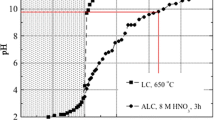Abstract
Controlled surface modification of biochar fibres derived from Luffa cylindrica sponges has been carried out by nitric acid and the degree of oxidation could be controlled by changing the acid concentration or the reaction time. The extent of surface oxidation has been quantified by acid–base titration and FTIR-spectroscopy. Furthermore, uranium binding has been studied as a function of various parameters and the experimental results show that even under strong acidic conditions the relative sorption is above 80 % and the sorption capacity of the biochar fibres for U(VI) at pH 3 is q max = 92 g kg−1.





Similar content being viewed by others
References
Hadjittofi L, Prodromou M, Pashalidis I (2014) Activated biochar derived from cactus fibres—preparation, characterization and application on Cu(II) removal from aqueous solutions. Bioresour Technol 159:460–464
Hadjittofi L, Pashalidis I (2015) Uranium sorption from aqueous solutions by activated biochar fibres investigated by FTIR spectroscopy and batch experiments. J Radioanal Nucl Chem 304(2):897–904
Wruck DA, Brachmann A, Sylwester ER, Allen PG, Palmer CEA (1999) Sorption of Np(V) by U(W) hydroxide solids UCRL-JC-135791. Lawrence Livermore National Laboratory, Livermore
Konstantinou M, Pashalidis I (2004) Speciation and spectrophotometric determination of uranium in seawater. Mediterr Mar Sci 5(1):55–60
Pashalidis I, Buckau G (2007) U(VI) mono-hydroxo humate complexation. J Radioanal Nucl Chem 273(2):315–322
Sun Y, Yang S, Chen Y, Ding C, Cheng W, Wang X (2015) Adsorption and desorption of U(VI) on functionalized graphene oxides: a combined experimental and theoretical study. Environ Sci Technol 49:4255–4262
Maher K, Bargar JR, Brown GE Jr (2012) Environmental speciation of actinides. Inorg Chem 52(7):3510–3532
Prodromou M, Pashalidis I (2013) Copper (II) removal from aqueous solutions by adsorption on non-treated and chemically modified cactus fibres. Water Sci Technol 68(11):2497–2504
Prodromou M, Pashalidis I (2013) Uranium adsorption by non-treated and chemically modified cactus fibres in aqueous solutions. J Radioanal Nucl Chem 298(3):1587–1595
Ai L, Luo X, Lin X, Zhang S (2013) Biosorption behaviors of uranium (VI) from aqueous solution by sunflower straw and insights of binding mechanism. J Radioanal Nucl Chem 298(3):1823–1834
Caccin M, Giacobbo F, Da Ros M, Besozzi L, Mariani M (2013) Adsorption of uranium, cesium and strontium onto coconut shell activated carbon. J Radioanal Nucl Chem 297(1):9–18
Acknowledgments
The authors would like to thank Mr. Argyris Ioannou for the supply of the Luffa cylindrica sponges.
Author information
Authors and Affiliations
Corresponding author
Electronic supplementary material
Below is the link to the electronic supplementary material.
Rights and permissions
About this article
Cite this article
Liatsou, I., Michail, G., Demetriou, M. et al. Uranium binding by biochar fibres derived from Luffa cylindrica after controlled surface oxidation. J Radioanal Nucl Chem 311, 871–875 (2017). https://doi.org/10.1007/s10967-016-5063-3
Received:
Published:
Issue Date:
DOI: https://doi.org/10.1007/s10967-016-5063-3




